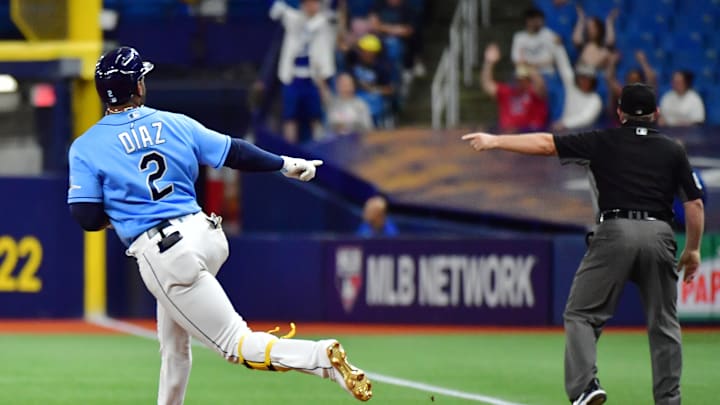The Tampa Bay Rays are entering the 2022 season as one of the most hyped ballclubs in the league, with three consecutive playoff appearances, a 2020 World Series appearance and the best record in the American League in 2021. Yet, with as much adoration as the front office gets for fielding competitive teams, the ballclub still is the remaining piece in completing the "Champa Bay" trifecta.
One of the many ways that the Rays find their talent is through an influx of trades, as is the case for corner infielder Yandy Diaz. Diaz was a depth piece for Cleveland when the Rays, Mariners and Indians complete a five-player, three-team swap in the deal that saw Jake Bauers head to the now-Guardians and Edwin Encarnacion head to Seattle.
Diaz was 27 at the time of the deal with only one MLB home run in 88 games, having posted a 94 OPS+, rating six percent below the league-average offensive production. It's evident by giving up their former number five prospect that the Rays saw something intriguing in Diaz's bat and thus far in Tampa, he's proven them correct. Although Diaz has been plagued by injuries in the first three seasons as a Ray, he's come up big in key moments. In the 2019 Wild Card Game, Diaz hit two home runs to advance the Rays to the ALDS, in his first game back from a foot fracture.
Tampa Bay Rays IF Yandy Diaz looks to elevate the ball in 2022
The footage above is what Yandy Diaz has become for the Rays. The patience, strike zone command and line drives. In 2020, Yandy Diaz walked more than he struck out. In 2021, Diaz struck out only 16 more times than he walked. He's in the 90th percentile for BB rate and 89th percentile for maximum exit velocity.
With a career .308 batting average on balls in play, a high on-base percentage and how powerful Yandy Diaz is, all of the peripherals reflect that Diaz should be one of the best power hitters in the league. Yet, he isn't, and perhaps a significant amount of the problem is related to his 78% combined line drive and groundball percentage.
With a maximum EV in the top 89% of baseball and a .308 batting average on balls in play, it's indicated that Diaz hits the ball hard and keeps the ball out of gloves. Unfortunately, the power isn't going to be there if Diaz primarily hits the ball to gaps and/or on the ground. Diaz has been a solid player, posting a 112 OPS+ and rating 12% better than the average hitter over his career, yet for a player with a .359 lifetime OBP, his .406 SLG seems relatively low. Overall, it's led to an above-average .765 OPS that ultimately isn't anything spectacular to write home about.
Yandy Diaz's fly ball percentage for his career is 17.1%, more than 5% lower than MLB's average fly ball percentage. The ideal launch angle to get the most out of a players power is anywhere from 15-20, a far cry from Diaz's career 3.9 launch angle. Diaz hits the ball the opposite way at a rate 6.5% higher than the average major leaguer, while a majority of his power is seen when he pulls the ball. Diaz pulls the ball at a rate 10% lower than the average player.
In his stance, Diaz plants his front foot on a rotation after a slight leg kick as his bat goes directly to the ball. While the leg kick helps him generate the most amount of power possible while not selling out his bat path, the bat takes what is given with the pitch. The swing is fluid, but it isn't designed to put the ball into the air as it's a more old-school approach to hitting. Due to how much Diaz uses the entire field with this specific swing, the ball gets deep into his bat, missing the barrel on routine. It's hard to hit homeruns if you're not hitting the ball with the barrel as that's where the best point of hard-contact is traditionally derived from.
It's well documented how patient Diaz is at the plate, which is why he's a productive player despite the lack of power one may anticipate, and how well Diaz does at waiting for his pitch. If Diaz sacrifices hitting the ball to all fields and waits for his pitch, not only may he see a walk increase but he may also find the barrel of the bat at a higher rate than the pedestrian 6.7% he has over his MLB career.
Upping the barrel percentage and potentially increasing the launch angle of Diaz would increase his flyball rate. Though doing this, however, could jeopardize his .308 batting average on balls in play as it'd decrease the amount of line drives to all fields, potentially making it easier to shift.
Regardless, Yandy Diaz is a very soild MLB player whose underlying numbers don't reflect the results, or lack thereof. The underlying numbers are significantly better than the results he's posted, giving the Tampa Bay front office confidence that the results will only improve going forward.
